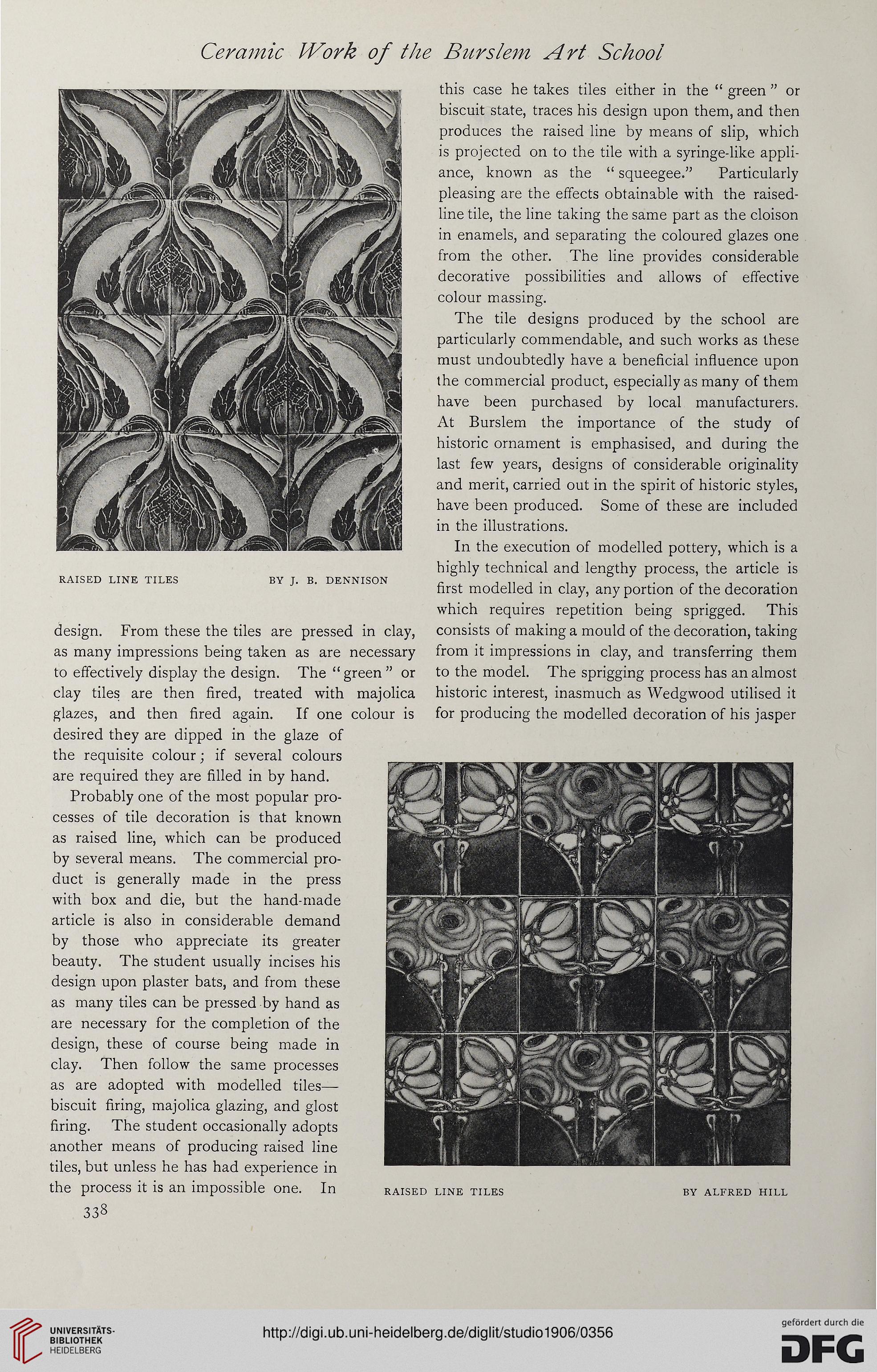Ceramic IVork of the Bur stem A rt School
this case he takes tiles either in the “ green ” or
biscuit state, traces his design upon them, and then
produces the raised line by means of slip, which
is projected on to the tile with a syringe-like appli-
ance, known as the “ squeegee." Particularly
pleasing are the effects obtainable with the raised-
line tile, the line taking the same part as the cloison
in enamels, and separating the coloured glazes one
from the other. The line provides considerable
decorative possibilities and allows of effective
colour massing.
The tile designs produced by the school are
particularly commendable, and such works as these
must undoubtedly have a beneficial influence upon
the commercial product, especially as many of them
have been purchased by local manufacturers.
At Burslem the importance of the study of
historic ornament is emphasised, and during the
last few years, designs of considerable originality
and merit, carried out in the spirit of historic styles,
have been produced. Some of these are included
in the illustrations.
In the execution of modelled pottery, which is a
highly technical and lengthy process, the article is
RAISED LINE TILES BY J. B. DENNISON - ^ . . . . . ,
first modelled in clay, any portion of the decoration
which requires repetition being sprigged. This
design. From these the tiles are pressed in clay, consists of making a mould of the decoration, taking
as many impressions being taken as are necessary from it impressions in clay, and transferring them
to effectively display the design. The “ green ” or to the model. The sprigging process has an almost
clay tiles are then fired, treated with majolica historic interest, inasmuch as Wedgwood utilised it
glazes, and then fired again. If one colour is for producing the modelled decoration of his jasper
desired they are dipped in the glaze of
the requisite colour; if several colours
are required they are filled in by hand.
Probably one of the most popular pro-
cesses of tile decoration is that known
as raised line, which can be produced
by several means. The commercial pro-
duct is generally made in the press
with box and die, but the hand-made
article is also in considerable demand
by those who appreciate its greater
beauty. The student usually incises his
design upon plaster bats, and from these
as many tiles can be pressed by hand as
are necessary for the completion of the
design, these of course being made in
clay. Then follow the same processes
as are adopted with modelled tiles—
biscuit firing, majolica glazing, and glost
firing. The student occasionally adopts
another means of producing raised line
tiles, but unless he has had experience in
the process it is an impossible one. In raised line tiles
338
BY ALFRED HILL
this case he takes tiles either in the “ green ” or
biscuit state, traces his design upon them, and then
produces the raised line by means of slip, which
is projected on to the tile with a syringe-like appli-
ance, known as the “ squeegee." Particularly
pleasing are the effects obtainable with the raised-
line tile, the line taking the same part as the cloison
in enamels, and separating the coloured glazes one
from the other. The line provides considerable
decorative possibilities and allows of effective
colour massing.
The tile designs produced by the school are
particularly commendable, and such works as these
must undoubtedly have a beneficial influence upon
the commercial product, especially as many of them
have been purchased by local manufacturers.
At Burslem the importance of the study of
historic ornament is emphasised, and during the
last few years, designs of considerable originality
and merit, carried out in the spirit of historic styles,
have been produced. Some of these are included
in the illustrations.
In the execution of modelled pottery, which is a
highly technical and lengthy process, the article is
RAISED LINE TILES BY J. B. DENNISON - ^ . . . . . ,
first modelled in clay, any portion of the decoration
which requires repetition being sprigged. This
design. From these the tiles are pressed in clay, consists of making a mould of the decoration, taking
as many impressions being taken as are necessary from it impressions in clay, and transferring them
to effectively display the design. The “ green ” or to the model. The sprigging process has an almost
clay tiles are then fired, treated with majolica historic interest, inasmuch as Wedgwood utilised it
glazes, and then fired again. If one colour is for producing the modelled decoration of his jasper
desired they are dipped in the glaze of
the requisite colour; if several colours
are required they are filled in by hand.
Probably one of the most popular pro-
cesses of tile decoration is that known
as raised line, which can be produced
by several means. The commercial pro-
duct is generally made in the press
with box and die, but the hand-made
article is also in considerable demand
by those who appreciate its greater
beauty. The student usually incises his
design upon plaster bats, and from these
as many tiles can be pressed by hand as
are necessary for the completion of the
design, these of course being made in
clay. Then follow the same processes
as are adopted with modelled tiles—
biscuit firing, majolica glazing, and glost
firing. The student occasionally adopts
another means of producing raised line
tiles, but unless he has had experience in
the process it is an impossible one. In raised line tiles
338
BY ALFRED HILL




